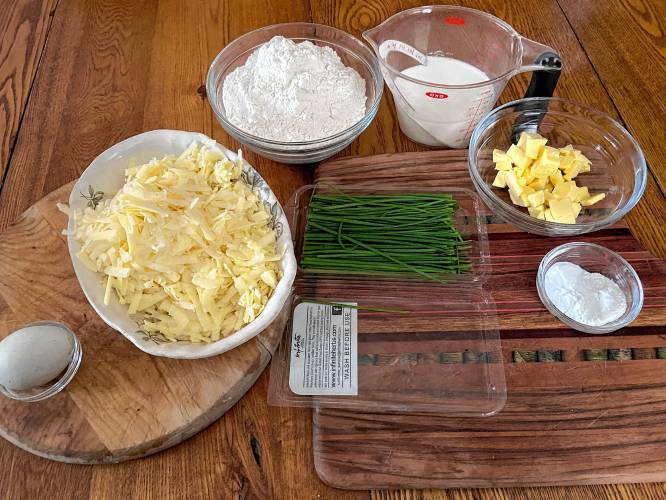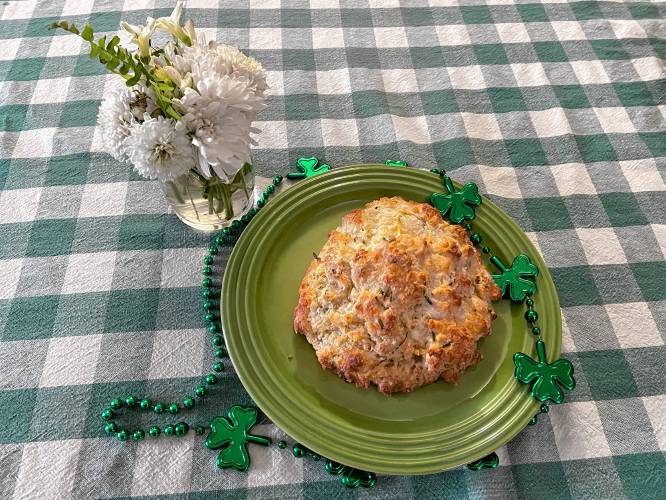A bread that unites us all: For St. Patrick’s Day, a savory soda bread with cheese and chives
| Published: 03-12-2024 4:06 PM |
I think of my mother and her grandmother whenever I get ready for St. Patrick’s Day. I forage in the basement for my light-up shamrock (which a neighbor whom I shall not name says makes the house look like a low-rent tavern). I affix it to a window, then go to my dress-up closet to pull out green clothing.
When my mother saw me in my green shirt, glasses, and hat (I save the green boa for evening wear), she invariably remarked, “Your great grandmother would have been appalled.”
Indeed, Katherine Scott Hallett was not a person known for wearing green on March 17. Born in 1860, she died long before I was born, but I heard stories about her frequently as I grew up.
To say that my mother disliked her grandmother would be an understatement. Mad Katie (as we sometimes call her in the family) had no tolerance for little girls with spirit. My mother was chock full of spirit.
They couldn’t even make it through greeting each other without getting into a fight. Katie only wanted to be called “Grandmother,” deeming any less formal name beneath her dignity. She also believed that the word “hello” was sacrilegious. In her view it was just an excuse for saying “oh, hell” backward.
Of course, it gave little Janice a great deal of pleasure to arrive at her grandmother’s red brick house in Clyde, New York, and holler, “Hello, Grandma!” at the top of her lungs. Things went downhill from there.
What, you may ask, does this have to do with wearing green for St. Patrick’s Day? Katie came to this country from Canada, but her family was Scots-Irish.
Her clan took part in one of the waves of settlement in Ireland by Protestant Scots. These settlements were encouraged, even sponsored, by the English.
Article continues after...
Yesterday's Most Read Articles
 Police report details grisly crime scene in Greenfield
Police report details grisly crime scene in Greenfield
 Authorities ID victim in Greenfield slaying
Authorities ID victim in Greenfield slaying
 State records show Northfield EMS chief’s paramedic license suspended over failure to transport infant
State records show Northfield EMS chief’s paramedic license suspended over failure to transport infant
 New buyer of Bernardston’s Windmill Motel looks to resell it, attorney says
New buyer of Bernardston’s Windmill Motel looks to resell it, attorney says
 On The Ridge with Joe Judd: What time should you turkey hunt?
On The Ridge with Joe Judd: What time should you turkey hunt?
 Ethics Commission raps former Leyden police chief, captain for conflict of interest violations
Ethics Commission raps former Leyden police chief, captain for conflict of interest violations
For centuries the rulers of England deluded themselves with the belief that if they kept adding to the Protestant portion of the Irish population they would eventually weaken the hold of the Catholic Church in Ireland and subdue the will of the Irish to rule themselves.
As a Protestant Irishwoman, Katie believed in wearing orange on St. Patrick’s Day to celebrate the victory of Protestant William of Orange over his Catholic father-in-law, James II of England, in the battle of the Boyne in 1690.
This Irish victory helped ensure that William and his wife Mary sat on the throne of England, Scotland, and Ireland. It also ensured that Protestants would have the upper hand in Ireland for centuries to come, leading to violence and resentment on both ends of the Irish religious spectrum.
To Katie, wearing orange on St. Patrick’s Day was a tactic in the ongoing battle between Catholics and Protestants. This battle remained vital to her family long after they settled on this continent.
In many ways, I have sympathy for Mad Katie. Far from most of her family after moving to the United States, she lost her husband to pernicious anemia at a relatively young age. In her middle years, the rigidity of her personality morphed into dementia. She became even more alienated from those around her.
I have a feeling that at some level she had a genuine affection for my mother, who was by all accounts a cute child. (She turned into a cute old lady.) Sadly, Katie was unable to express that affection.
My great-grandmother would no doubt have scowled at my St. Patrick’s Day décor and wardrobe. I look fabulous in green, however, so I’m ignoring that thought.
Happily, I can pay tribute to both Catholics and Protestants in Ireland by whipping up some traditional Irish dishes in my kitchen.
Mad Katie may have hated her Catholic neighbors. Nevertheless, she was as partial as the next Irish-American girl to such foods as soda bread and Irish stew.
I make my standard soda bread (which I have featured in this paper before) each St. Patrick’s Day. Today, I’m sharing a recipe adapted (with thanks!) from Cabot Cheese.
As soon as I saw Cabot’s Cheddar Soda Bread I knew it would be just the thing to serve with corned beef and cabbage or Irish beef or lamb stew. I have changed the recipe a little, of course.
First, I upped the Irish ante by using Irish cheddar. Cabot’s cheddar might taste sharper — Irish cheddar seems to be milder than our standard sharp cheese — but this version still had lots of cheesiness. It was extra creamy as well.
Second, I used salted Irish butter, which is rich and yummy, instead of Cabot butter. Cabot’s original recipe had a little salt in the ingredients list, but between the salted butter and the cheese, I found that this recipe had plenty of sodium. (I write this as one who adores salt.)
Third, I threw in some chives. They lent their bright flavor to the bread and gave it specks of green. You could also add other items to taste: Irish bacon, perhaps, or caraway seeds, which are often used in soda bread and pair nicely with the cheese.
Despite the warm weather we have enjoyed frequently this winter, chives have yet to appear in my herb garden, so I had to purchase them. Even the store-bought chives tasted like spring.
Enjoy — but eat sparingly. This bread is very filling.
Somewhere in my house there is a photo of Mad Katie — but I can’t find it! So I am leaving you with an image of her house in Clyde, New York. The painting is signed, “B. Christian.”
Ingredients:
2 1/2 cups flour
2 teaspoons baking powder
1 teaspoon baking soda
2 tablespoons chopped fresh chives (not too finely chopped; you want to be able to see them in the bread)
1/4 cup (1/2 stick) salted Irish butter, cut into small pieces
1/2 pound Irish cheddar, grated
1 cup buttermilk
1 egg
Instructions:
Preheat the oven to 375. Lightly grease a cookie sheet or line it with a silicone mat or parchment paper.
In a medium bowl whisk together the flour, the baking powder, the baking soda, and the salt. Stir in the chives, followed by the butter and the cheese. Use a fork or a pastry blender to mix everything together. You will still have little pieces of cheese, which is just fine.
In a small bowl or a measuring cup, whisk together the buttermilk and the egg. Stir them gently into the dry ingredients.
Turn the mixture onto a lightly floured board and knead it a few times, until it holds together a little. It will be sticky.
You may make either one loaf or two. For one loaf, shape the dough into a mound on the prepared cookie sheet. Flatten the mound slightly to spread it out.
I like making two smaller loaves, also flattened, in similar fashion. That way I have one to serve and one to give away.
Bake until your soda bread has light brown spots, and a toothpick inserted into the center comes out clean — 35 to 40 minutes for the larger loaf or 25 to 30 for the two smaller loaves.
Slice into small wedges and serve warm with soft Irish butter. Serves 14 to 16.
Tinky Weisblat is an award-winning cookbook author and singer known as the Diva of Deliciousness. Visit her website, TinkyCooks.com.




 Proof that it’s never too late: Solo exhibit and free workshops honor the late Frederick Gao, a Belchertown resident who became a painter in his last five years
Proof that it’s never too late: Solo exhibit and free workshops honor the late Frederick Gao, a Belchertown resident who became a painter in his last five years Self-expression on display: ServiceNet members’ artworks on view at Greenfield Public Library through end of May
Self-expression on display: ServiceNet members’ artworks on view at Greenfield Public Library through end of May Embracing both new and old: Da Camera Singers celebrates 50 years in the best way they know how
Embracing both new and old: Da Camera Singers celebrates 50 years in the best way they know how Time to celebrate kids and books: Mass Kids Lit Fest offers a wealth of programs in Valley during Children’s Book Week
Time to celebrate kids and books: Mass Kids Lit Fest offers a wealth of programs in Valley during Children’s Book Week
